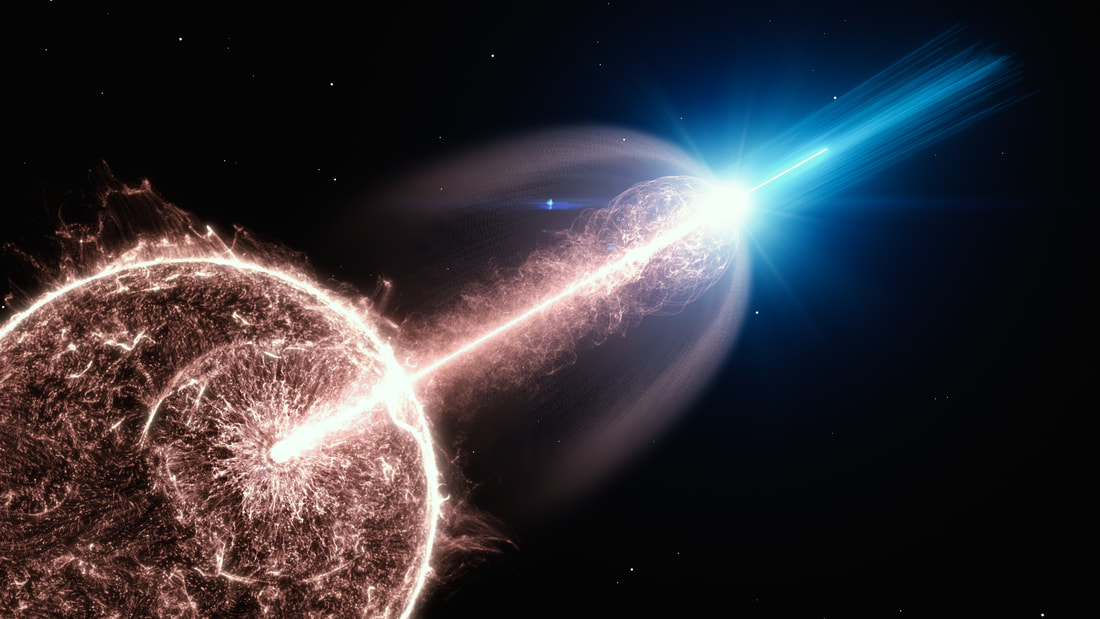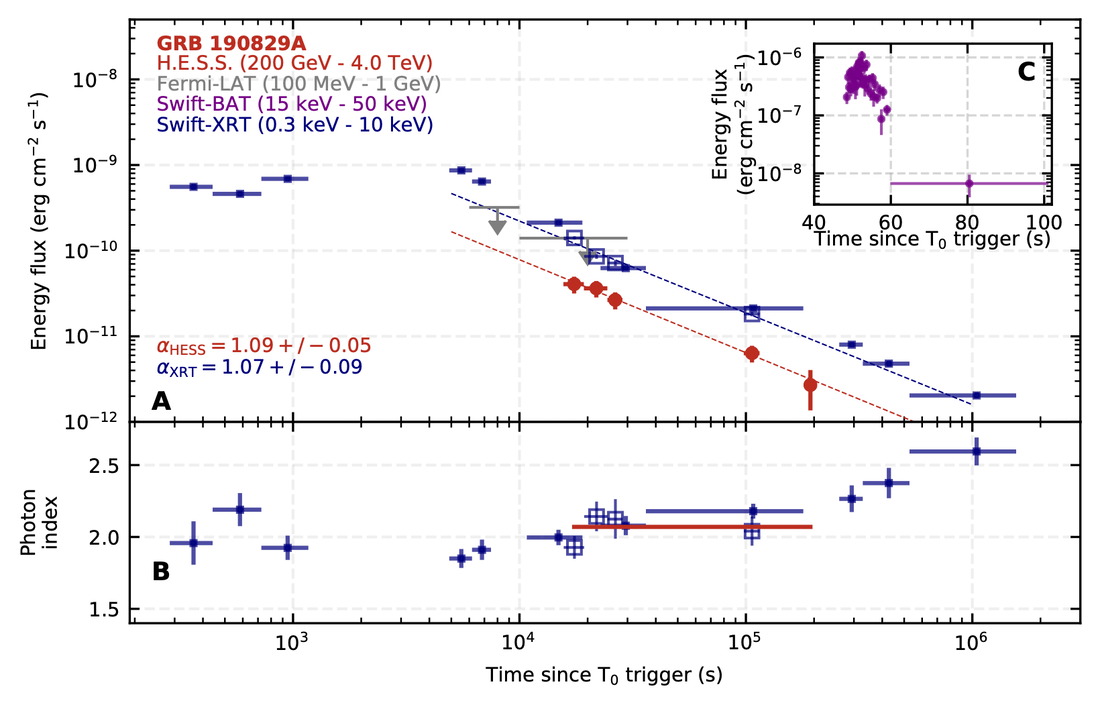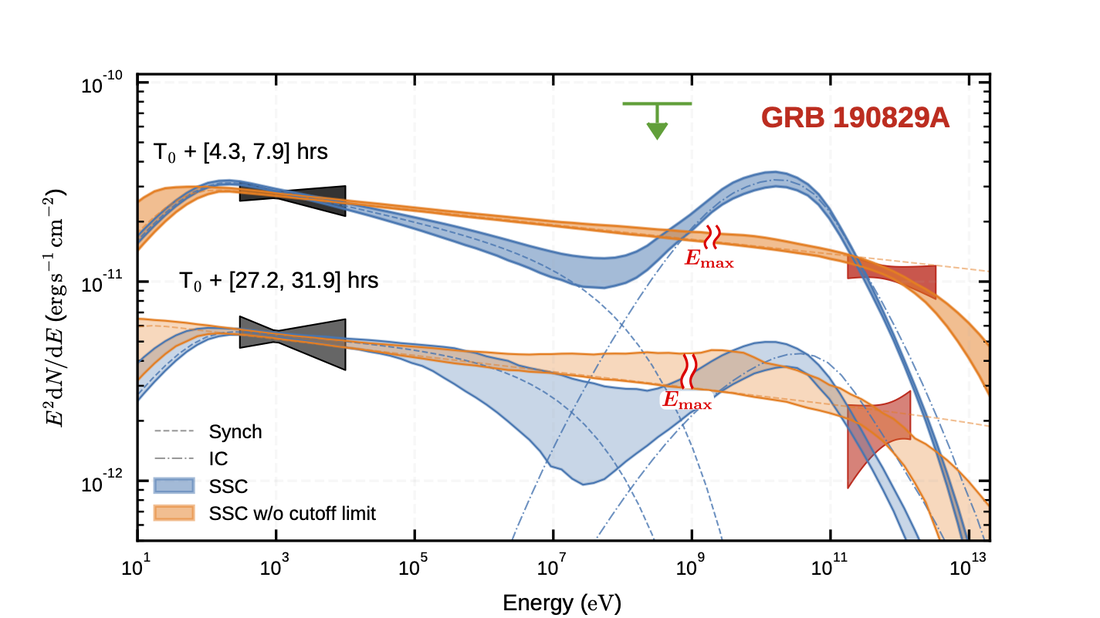|
The paper is out! Finally! After almost 2 years we can finally talk openly about the amazing observations we obtained with H.E.S.S. in our campaign in late autumn 2019. A bit of context: we have been trying to catch very-high-energy gamma-ray emission from a Gamma-Ray Burst (GRB) since the dawn of Imaging Air Cherenkov Telescopes, i.e. since over two decades. The GRB program of H.E.S.S. is the longest running observation program of the collaboration. Every year for almost 20 years, the observations and trigger conditions are discussed and updated and students sign up every month for 'expert-on-call' shifts that mean that they'll be woken up in the middle of the night to guide the on-site shift crew in GRB observations, These efforts came finally to fruition with the H.E.S.S. observations of GRB 180720B, the first detection of a GRB by an IACT ever. Rather surprisingly, these observations were made several hours after the burst in the period of fading X-ray emission called the afterglow. More in line with expectations, a few months later MAGIC detected a strikingly strong signal from GRB 190114C in the first minutes after the burst. Two bursts in ~20 years... Artist's impression of a relativistic jet of a gamma-ray burst (GRB), breaking out of a collapsing star, and emitting very-high-energy photons. Credit: DESY, Science Communication Lab In the evening of August 29, 2019 a GRB was detected by the Fermi and shortly later by the Swift X-ray satellites. Business as usual for the H.E.S.S. Transients group (that was still part of the larger Extragalactic Science group at that time): the automatic VoSystem calculated the best time window for H.E.S.S. observations which started roughly 4h30 after the burst. To make things more complex multiple ToO programs (including a Galactic Nova outburst and an AGN flaring activity) requested observations for the same night. These conflicts could be settled and observations on the GRB were scheduled. Sidenote: the observations were almost cancelled because the shift crew confused a retraction of a GW event by Virgo/LIGO with a retraction of the GRB. Luckily our expert-on-call (Quentin, a PhD student from LAPP/Annecy) reacted quickly and clarified the situation. So far so good. Although the next day was Saturday I got up early to drive my son and some friends to a basketball camp. This plan fell apart as soon as I checked the shift report from the last night. A signal in the real-time analysis during the observations of the GRB had caused the shift crew and the expert-on-call to extend the observations beyond the originally scheduled window! A frantic checking of the data quality and analysis results followed. Luckily a family friend jumped in to take care of the basketball players in the meantime ;-) I quickly drafted a text for a GCN circular and Astronomers Telegram to allow for our friends operating telescopes in South America to react while it was still dark enough for observations. Maybe I should have stopped for a while and got some coffee: it might have prevented me messing up the dates mention in the GCN/ATEL: the observations took well place in August and not July 🤦♂️. The rest is history... We continued to observe the region of the burst for several days 'just in case', set up an analysis team, rapidly retrieved the data from Namibia (using our lessons learned from GW170817), went through a long list of data quality checks before unblinding the high level analyses. I signed up to conduct one of the two independent analyses, the other one (which would in the end be used for the plots in the paper) was led by Edna (PhD student at MPIK, Heidelberg). Towards the end of the year we had a first meeting in Desy-Zeuthen to compare the results of the two analyses. In preparation of the meeting (i.e. the night before in my hotel room in Berlin) I ran the analysis for the first time on an extended dataset beyond the first two nights of observations. To my surprise I found a signal even in the third night of data taking! In total we could follow the emission for over 56h! This really shattered (at least my own) earlier expectations and extrapolations from Fermi-LAT observations which rather pointed to timescales of minutes for the emission of high-energy photons from GRBs... The light-curve of GRB 190829A in X-rays and VHE gamma-rays (red points). For the first time we could follow the evolution of the emission over several days and show the similarity between the two energy domains. From Science, 2021 We then finalized the analyses and verified that both pipelines gave consistent results, which in the end took a few extra months due to some (in the end very minor) bugs/updates/changes/etc. in the software frameworks. But the fun was not over yet: the theoretical models based on inverse Compton emission that we just had "confirmed" with the papers on GRB 180720B and the MAGIC paper on GRB 190114C, did not fit the high resolution energy spectrum that we managed to derive due to the proximity of the burst. The "modelling group" led by Andrew from Desy-Zeuthen realized that we indeed may need to let go of one of the fundamental limits of synchrotron emission of high-energy electrons. This “burn-off limit” is determined by the balance of acceleration and cooling of the electrons within the accelerating region. Neglecting it allowed to describe the measured gamma-ray energy spectrum almost perfectly... Is this possible? Probably yes, but it would require a more complex configuration of different regions responsible for the acceleration and the synchrotron emission. Maybe also some completely different explanation is possible. Time and a lot of effort by the world-wide community will tell... The energy spectrum of GRB 190829A in the X-ray (gray butterflies) and VHE gamma-ray domains (red butterflies) are strikingly similar and cannot easily be explained by the usually used SSC description (blue bands). Removing the constrains on the maximum energy of the accelerated electrons allows to fit both domains as pure synchrotron radiation. From Science, 2021 In the meantime we are updating the H.E.S.S. observation program with the lessons learned from GRB 190829A to increase our changes for additional GRB observations and prepare the observations with the Cherenkov Telescope Array and especially with the first Large Size Telescope that is already taking data on La Palma. Exciting times! Stay tuned... The paper is available here: science.sciencemag.org/cgi/doi/10.1126/science.abe8560 and don't miss the phenomenal animation done by DESY, Science Communication Lab: A few other articles on the results:
0 Comments
Leave a Reply. |
AuthorMyself ;-) Archives
January 2024
Categories
All
|



 RSS Feed
RSS Feed